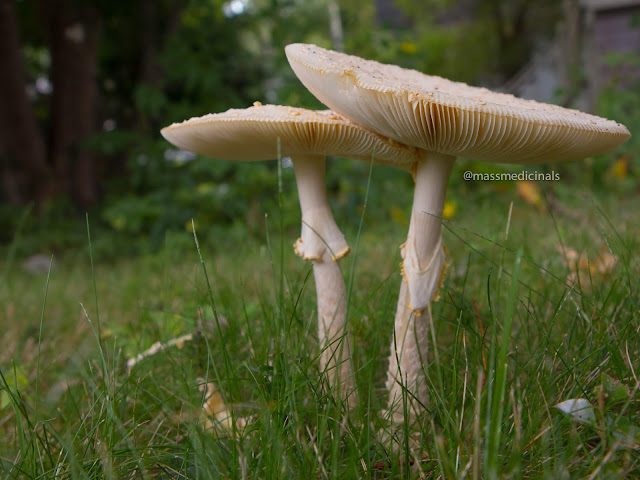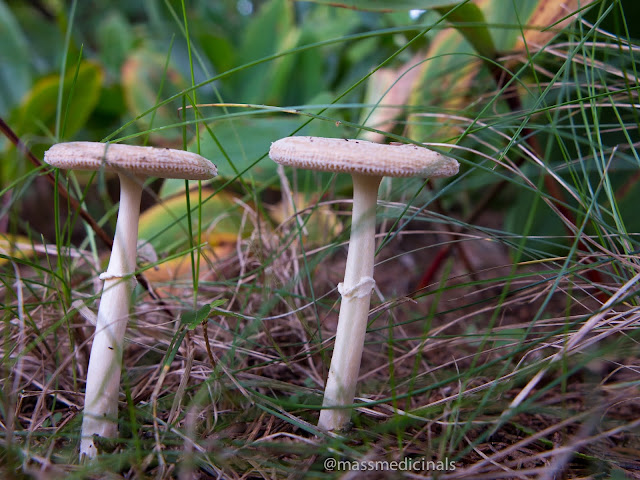Mass Medicinals
Well-Known Member
With all of the rain we have received over the last couple weeks, and the relatively high humidity levels our garden and surrounding area has been invaded with mushrooms.

It's not a good sign for fighting bud rot within the cannabis garden, when all around the plants we have wild mushrooms sprouting up. Basically most of New England has been the perfect conditions for fungi.
But we did our best to remove them from the area. Not sure if those mushroom are even a threat to the cannabis plants.
And since we have no idea if these cool looking things are a problem. I'm more or less going to ignore that possibility and geek out on mushrooms for a bit

Anatomy of the mushrooms in these photos:
Cap: is a yellow and light brown color
Scales: yes, they are a off-white color
Gills: are prominent and well spaced
Ring: hangs off the plant and is white with bits of yellow (better example in the photos below)
Appearance seems to fade out as the mushrooms progress through their life cycle.
Compare the younger mushroom (above) with the two older ones (below).

A basic search on the web, led us to believe these are Amanita frostiana mushrooms.
According to wiki, this genus contains some 600 species, including some of the most toxic mushrooms to be found around the globe.

Some of those well known species include:
Amanita muscaria - also called the fly agaric and fly amanita. They contain muscimol and ibotenic acid. Primarily found in the cap of the mushroom. It is these two compounds and their interactions with the body that cause the psychoactive (hallucinogenic) effects. We are merely citing wiki and related sites for information, and are not promoting human consumption of these mushrooms.

Two other infamous mushrooms for their toxicity are:
Amanita bisporigera and Amanita ocreata - Also called Destroying Angel, what a name right?
It contains amatoxin which inhibits RNA polymerase II and III (just nod like that means something to us). Symptoms do not appear for 5-24 hours when most of the toxin has been absorbed by the kidney and liver. And it is at this time that the damage is irreversible. As little as half a mushroom cap can be fatal. And these can be confused for the magic mushroom variety.
Amanita phalloides - Death Cap. I mean if the name itself doesn't drive a little fear into you you. This excerpt hopefully will.
And quote, "The death cap is one of the most poisonous mushrooms in the northern hemisphere. It grows throughout the entire temperate zone of Europe, Asia and North Africa. It was carried (probably with tree seedlings) to North America and Australia. This amanita is responsible for most mushroom poisonings, and even small doses can be very dangerous. Resistance to the poison varies among individuals, so specifying a fatal dose is difficult. The poison - amanitin, damages the liver and kidneys. Initial symptoms occur 8 to 48 hours after ingestion. In this phase, the person experiences fatigue, stomach nausea, dizziness, headaches and feelings of cold, even freezing. The nausea intensifies, stomach aches occur, accompanied by strong retching and watery diarrhea, leading to dehydration, and eventual circulatory failure. This is usually the immediate cause of death in children. If the patient survives this phase, his condition appears to improve (usually the fourth day after ingestion). In the second phase, the kidneys fail, and sometimes the liver as well. Death usually occurs four to twelve days after ingestion."
Call your local poison control. Better yet don't go foraging for wild mushrooms if you aren't a pro...

I don't believe these are Amanita mushrooms they are a lot smaller. But still pretty cool looking. I sort of gave up on researching these ones after doing a serious deep dive into the Amanita genus.
Artsy photos are easy. Looking through a ton of photos for, white small mushrooms with ring, less fun.
Here's, "the odd pair"

Calling this one, "the loner"

And this, "mushroom deep in thought"

Anyways like I said, I have no idea if these mushrooms are going to negatively impact our cannabis garden. But it was fun photographing and researching them.
Please be careful even just handling mushrooms. After researching the more poisonous ones, I went and washed my hands a couple times just for good measure.
Happy Growing!!!
MM's

It's not a good sign for fighting bud rot within the cannabis garden, when all around the plants we have wild mushrooms sprouting up. Basically most of New England has been the perfect conditions for fungi.
But we did our best to remove them from the area. Not sure if those mushroom are even a threat to the cannabis plants.
And since we have no idea if these cool looking things are a problem. I'm more or less going to ignore that possibility and geek out on mushrooms for a bit

Anatomy of the mushrooms in these photos:
Cap: is a yellow and light brown color
Scales: yes, they are a off-white color
Gills: are prominent and well spaced
Ring: hangs off the plant and is white with bits of yellow (better example in the photos below)
Appearance seems to fade out as the mushrooms progress through their life cycle.
Compare the younger mushroom (above) with the two older ones (below).

A basic search on the web, led us to believe these are Amanita frostiana mushrooms.
According to wiki, this genus contains some 600 species, including some of the most toxic mushrooms to be found around the globe.

Some of those well known species include:
Amanita muscaria - also called the fly agaric and fly amanita. They contain muscimol and ibotenic acid. Primarily found in the cap of the mushroom. It is these two compounds and their interactions with the body that cause the psychoactive (hallucinogenic) effects. We are merely citing wiki and related sites for information, and are not promoting human consumption of these mushrooms.

Two other infamous mushrooms for their toxicity are:
Amanita bisporigera and Amanita ocreata - Also called Destroying Angel, what a name right?
It contains amatoxin which inhibits RNA polymerase II and III (just nod like that means something to us). Symptoms do not appear for 5-24 hours when most of the toxin has been absorbed by the kidney and liver. And it is at this time that the damage is irreversible. As little as half a mushroom cap can be fatal. And these can be confused for the magic mushroom variety.
Amanita phalloides - Death Cap. I mean if the name itself doesn't drive a little fear into you you. This excerpt hopefully will.
And quote, "The death cap is one of the most poisonous mushrooms in the northern hemisphere. It grows throughout the entire temperate zone of Europe, Asia and North Africa. It was carried (probably with tree seedlings) to North America and Australia. This amanita is responsible for most mushroom poisonings, and even small doses can be very dangerous. Resistance to the poison varies among individuals, so specifying a fatal dose is difficult. The poison - amanitin, damages the liver and kidneys. Initial symptoms occur 8 to 48 hours after ingestion. In this phase, the person experiences fatigue, stomach nausea, dizziness, headaches and feelings of cold, even freezing. The nausea intensifies, stomach aches occur, accompanied by strong retching and watery diarrhea, leading to dehydration, and eventual circulatory failure. This is usually the immediate cause of death in children. If the patient survives this phase, his condition appears to improve (usually the fourth day after ingestion). In the second phase, the kidneys fail, and sometimes the liver as well. Death usually occurs four to twelve days after ingestion."
Call your local poison control. Better yet don't go foraging for wild mushrooms if you aren't a pro...

I don't believe these are Amanita mushrooms they are a lot smaller. But still pretty cool looking. I sort of gave up on researching these ones after doing a serious deep dive into the Amanita genus.
Artsy photos are easy. Looking through a ton of photos for, white small mushrooms with ring, less fun.
Here's, "the odd pair"

Calling this one, "the loner"

And this, "mushroom deep in thought"

Anyways like I said, I have no idea if these mushrooms are going to negatively impact our cannabis garden. But it was fun photographing and researching them.
Please be careful even just handling mushrooms. After researching the more poisonous ones, I went and washed my hands a couple times just for good measure.
Happy Growing!!!
MM's


